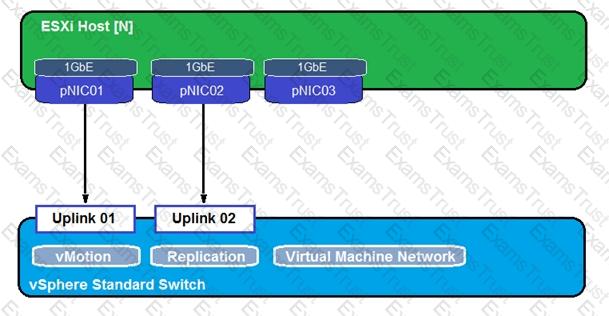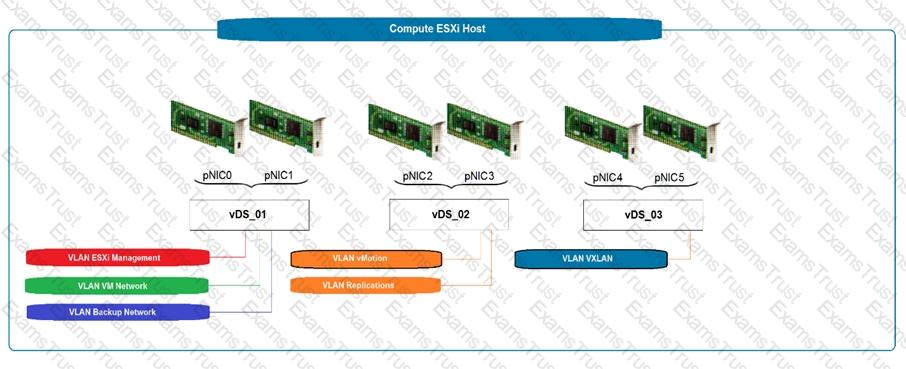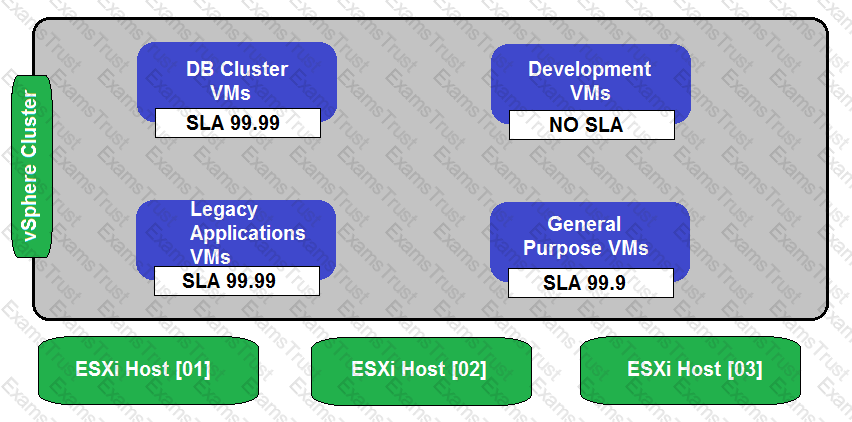Refer to the exhibit.

During a requirements gathering workshop, the customer shares the following about their existing ESXi host virtual networking infrastructure:
The customer confirms that:
Which two recommendations should the architect make in order to help the customer overcome their challenge? (Choose two.)
An architect is designing a new greenfield environment that will install ESXi on local disks. There is a requirement to streamline initial and future installations of ESXi hosts.
Which configuration option should the architect recommend for installing ESXi hosts to meet these requirements?
An architect is tasked with designing a new VMware software-defined data center (SDDC) using VMware vSAN. The architect uses a storage assessment tool to determine the storage requirements for the new vSAN cluster. The new SDDC is going to be deployed into the existing data center and must be connected to a shared core network switch.
The architect decides to use vSAN ReadyNodes with the following configuration:
Which element represents a risk that should be included in this design?
Which requirement would be classified as a functional requirement within the design documentation?
In a meeting to discuss the minimum viable product (MVP) deployment of a new customer-facing application, the key stakeholder shares details of the application components and the application administrators share details of performance and integrity tests for the application.
The application will be made up of the following components:
-Steps to confirm the web server is operating correctly will take 15 minutes after the application server is online.
-Steps to confirm application server integrity will take 15 minutes after the database is online.
-The database server will be managed by a database administrator, with an agreed service-level agreement (SLA) to restore and validate database services within one hour.
The existing VMware infrastructure offers a recovery point objective (RPO) of 5 minutes and recovery time objective (RTO) of 15 minutes through a combination of backups and replication.
In the event of an outage impacting all three application components, how long will it take for the application to recover and complete all checks?
An architect has 50 ESXi hosts to deploy and DHCP servers are not allowed on any network. Which automated host deployment method should the architect use?
Refer to the exhibit.
During a requirements gathering workshop, the architect shares the following diagram:

What should the architect recommend for guaranteed throughput for each service?
An architect is reviewing a physical storage design. The customer has specified that a new active-passive based storage array will be used to provide storage for the vSphere clusters.
Which configuration should for the architect recommended?
An architect is designing a new vSphere platform to meet a list of requirements from the security team.
Which two requirements would be classified as non-functional requirements? (Choose two.)
During a requirements gathering workshop, the customer provides the following information:
Which two recommendations should the architect make with regard to virtual networking? (Choose two.)
A customer requires the use of data encryption to ensure data is not accessible when a drive is removed from the primary storage platform. However, there is also a requirement to use deduplication and compression against all workloads in order to conserve space.
Which solution meets the customer requirements?
Which two of the listed requirements would be classified as manageability non-functional requirements? (Choose two.)
An architect is tasked with planning the design of a new vSphere environment. When commissioned, this environment will be used to migrate an existing set of virtual machines.
An inventory of the existing infrastructure, including configured vCPU, RAM and storage sizes has been provided.
In order for each virtual machine to be migrated, which two data sources with peak and average utilization data are required for sizing? (Choose two.)
An architect is tasked with designing a greenfield VMware software-defined data center (SDDC) solution that will be used to deliver a private cloud service for a customer.
During the initial meeting with the service owner and business sponsor, the customer has provided the following information to help inform the design:
Given the information from the customer, which two would be classified as assumptions within the design? (Choose two.)
Following a recent acquisition, an architect needs to merge IT assets into its current data center. The combined vSphere environment will need to run the newly acquired company’s virtual machines.
Network integration work has already been completed and the current environment has capacity to host all virtual machines. The Operations team needs to identify which virtual machines belong to the acquired company and report on their usage.
How should the architect merge the company’s assets and virtual machines?
Refer to the exhibit.
During a requirements gathering workshop, the customer shares the following diagram regarding their availability service-level agreements (SLAs):

The customer wants database application level availability to always take precedence. What should the architect recommend to meet the customer’s requirement?
Which of the listed requirements would be classified as a recoverability non-functional requirement?
An architect is finalizing the design for a new vCenter Server High Availability deployment.
What is one thing the architect must document in the design?
A customer provides the following list of requirements for their vSphere platform:
Which two of the listed requirements would be classified as non-functional requirements? (Choose two.)
An architect is preparing a design for a customer. Based on requirements, the architect recommends an HCI- based infrastructure with all-flash architecture. During the assessment, it is confirmed that the network throughput generated by virtual machines does not exceed 150 Mb/s.
What is the minimum number and type of network adapters in each server that the architect can recommend to ensure requirements are met and there is no single point of failure?
An architect is designing a new greenfield environment with 600 ESXi hosts in an automated fashion. The engineering department already has a PXE Boot server, TFTP server, and DHCP server set up with an NFS mount for their current Linux servers.
The architect must be able to demonstrate and meet a security requirement to have all infrastructure processes separated.
Which recommendation should the architect make for the ESXi host deployment?
An architect is considering placement of virtual machines within an existing VMware software-defined data center (SDDC).
During the discovery phase, the following information is documented:
Cluster One
Cluster Two
Cluster Three
Virtual Machine Resource Profile 1
Virtual Machine Resource Profile 2
Which two recommendations should the architect make for placement of the virtual machines to meet resource profile requirements? (Choose two.)
An architect is designing a vSphere environment for a customer and learns that the customer has:
Which two design decisions should the architect make to maximize data availability and data performance for this customer? (Choose two.)
An architect is designing a solution based on the following information:
Which recommendation for the configuration of vSphere High Availability (HA) should the architect include in the design?
An architect is tasked with expanding an existing VMware software-defined data center (SDDC) solution so that it can be used to deliver a virtual desktop infrastructure (VDI) service off-shore development activities.
The production environment is currently delivered across two geographically dispersed data centers. The two data centers are currently connected to each other through multiple diversely routed, high bandwidth and low latency links. The current operations management components are deployed to a dedicated management cluster that is configured with N+1 redundancy. The current VMware software-defined data center (SDDC) has a monthly availability target of 99.5%, which includes all management components.
The customer requires that the new solution scale to support the concurrent running of 500 persistent virtual desktops. The virtual desktops must not share the same virtual infrastructure as existing virtual machines, but can be managed using the same VMware operations management components. Any new VDI service management components must be installed into the management cluster. There is no requirement to back up the virtual desktops because all relevant user data is stored centrally. The VDI service is providing business critical services and must have an availability target of 99.9%.
Given the information from the customer, which two assumptions would the architect include in the design? (Choose two.)
During a requirements gathering workshop, the customer provides the following requirement (REQ) and constraints (CON):
Which two design decisions should the architect make to meet the customer requirement? (Choose two.)